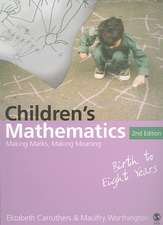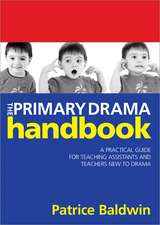Thinking Strategies for Science, Grades 5-12
Autor Sally Bermanen Limba Engleză Paperback – 22 iul 2008
-A new section on designing your own science activities
-An expanded discussion of assessment methods
-An assortment of handy reproducibles to use with your lesson plans
| Toate formatele și edițiile | Preț | Express |
|---|---|---|
| Paperback (1) | 249.43 lei 6-8 săpt. | |
| SAGE Publications – 22 iul 2008 | 249.43 lei 6-8 săpt. | |
| Hardback (1) | 478.16 lei 6-8 săpt. | |
| SAGE Publications – 22 iul 2008 | 478.16 lei 6-8 săpt. |
Preț: 249.43 lei
Nou
Puncte Express: 374
Preț estimativ în valută:
47.73€ • 49.31$ • 39.73£
47.73€ • 49.31$ • 39.73£
Carte tipărită la comandă
Livrare economică 26 martie-09 aprilie
Preluare comenzi: 021 569.72.76
Specificații
ISBN-13: 9781412962896
ISBN-10: 1412962897
Pagini: 144
Dimensiuni: 216 x 279 x 9 mm
Greutate: 0.41 kg
Ediția:Second Edition
Editura: SAGE Publications
Colecția Corwin
Locul publicării:Thousand Oaks, United States
ISBN-10: 1412962897
Pagini: 144
Dimensiuni: 216 x 279 x 9 mm
Greutate: 0.41 kg
Ediția:Second Edition
Editura: SAGE Publications
Colecția Corwin
Locul publicării:Thousand Oaks, United States
Recenzii
"Provides helpful, guided, step-by-step procedures for new and seasoned teachers to review and reassess their methods for teaching students how to collect, organize, and analyze new ideas."
"The ideas will be valuable to teachers seeking ways to engage students in learning. Presents strategies to engage students in making meaning out of prior knowledge, texts, and specific content."
"The ideas will be valuable to teachers seeking ways to engage students in learning. Presents strategies to engage students in making meaning out of prior knowledge, texts, and specific content."
Cuprins
Preface
Acknowledgments
About the Author
Introduction
Part I. Gathering Information
1. The People Search: Getting to Know You
2. KNL: What Do We Know? What Do We Need to Know? What Have We Learned?
3. Asking Questions: What I Really Do Not Understand Is...
4. The Prediction Guide: Becoming More Focused Readers
5. The Importance of Using Precise Labels: Latch Onto a Label
6. Think-Pair-Share: And the Answer Is. . .
7. Making Observations: It Makes Cents to Me
8. Accurate Observations: Hide in Plain Sight
Part II. Processing Information
9. Mental Modeling: What Is Behind Door Number Two?
10. Becoming Better Listeners: What a Bright Idea
11. The Venn Diagram: Frogs and Salamanders
12. Using a Fishbone: The Planets Organized
13. One Way to Use a Matrix: That Is My Pet Matrix
14. Looking for Attributes: Scavenger Hunt
Part III. Analyzing and Applying Information
15. Lateral Thinking: Cook's Choice
16. An Individual Writing Activity: Dear Uncle Chester
17. A Jigsaw: Elements, Compounds, and Mixtures
18. Follow-Up for Guided Practice: Elements, Compounds, and Mixtures
19. Using a Storyboard: Home on the Range Just Is Not the Same
20. Mapping: Making Sense of What We Know
21. Right-Angle Thinking: Molecules in Motion
Part IV. Designing Your Own Activities
22. Designing Your Own Activities: Your Turn!
Reproducibles
References and Recommended Readings
Index
Acknowledgments
About the Author
Introduction
Part I. Gathering Information
1. The People Search: Getting to Know You
2. KNL: What Do We Know? What Do We Need to Know? What Have We Learned?
3. Asking Questions: What I Really Do Not Understand Is...
4. The Prediction Guide: Becoming More Focused Readers
5. The Importance of Using Precise Labels: Latch Onto a Label
6. Think-Pair-Share: And the Answer Is. . .
7. Making Observations: It Makes Cents to Me
8. Accurate Observations: Hide in Plain Sight
Part II. Processing Information
9. Mental Modeling: What Is Behind Door Number Two?
10. Becoming Better Listeners: What a Bright Idea
11. The Venn Diagram: Frogs and Salamanders
12. Using a Fishbone: The Planets Organized
13. One Way to Use a Matrix: That Is My Pet Matrix
14. Looking for Attributes: Scavenger Hunt
Part III. Analyzing and Applying Information
15. Lateral Thinking: Cook's Choice
16. An Individual Writing Activity: Dear Uncle Chester
17. A Jigsaw: Elements, Compounds, and Mixtures
18. Follow-Up for Guided Practice: Elements, Compounds, and Mixtures
19. Using a Storyboard: Home on the Range Just Is Not the Same
20. Mapping: Making Sense of What We Know
21. Right-Angle Thinking: Molecules in Motion
Part IV. Designing Your Own Activities
22. Designing Your Own Activities: Your Turn!
Reproducibles
References and Recommended Readings
Index
Notă biografică
Sally Berman specializes in teaching educators how to use practical strategies that expand student teamwork, cognition, metacognition, and self-evaluation skills. She developed and tested many of her ideas during her 30 years of teaching science in a large Chicago-area high school. Berman regularly presents at workshops and conferences and has taught graduate courses for SkyLight Professional Development in conjunction with St. Xavier University and Cumberland University.
Descriere
With reproducibles and a new section on designing activities, this revised edition presents strategies and standards-aligned lessons that strengthen student comprehension and higher-level thinking skills in science.












